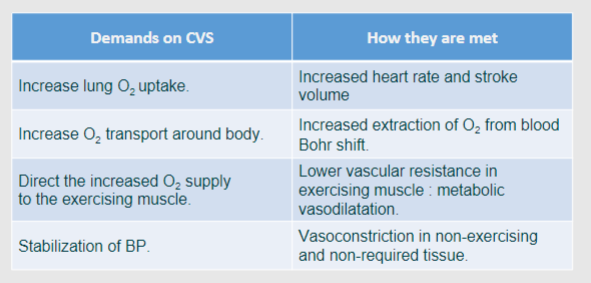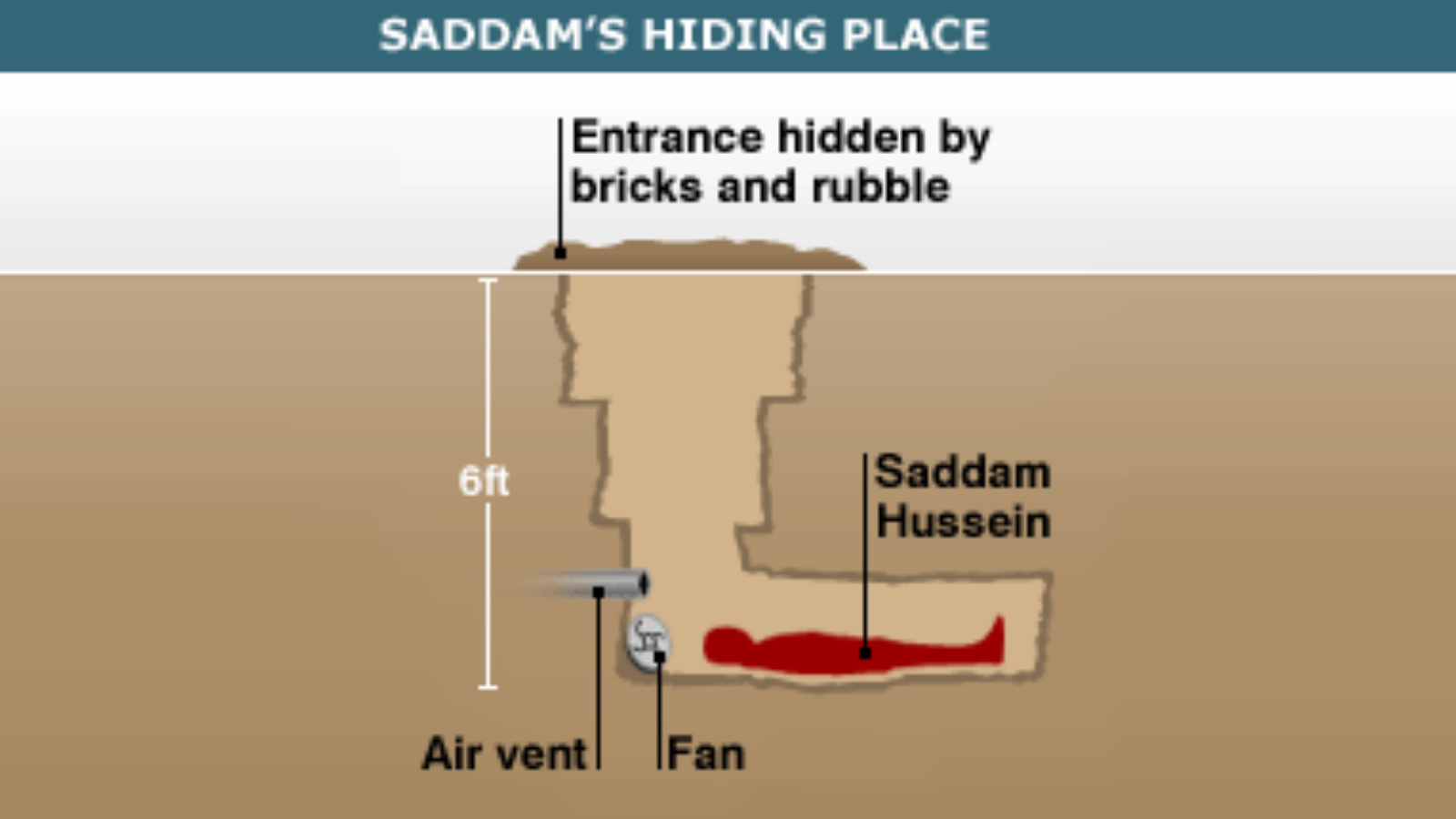
Coordinated Responses of the CVS - Gravity & Exercise (Physiology)
Session summary The effects of gravity range from standing up and sitting down to orbiting the earth. Responses to all these situations by the cardiovascular system are reviewed. Similarly, the cumulative adaptive changes required during exercise are explored. This will integrate many of the ideas presented in earlier lectures and show how they interact in real physiological situations where many components of the CVS co-ordinate together to deal with the everyday demands of life. The principle of adaption by integration of lots of small responses is explained. Learning outcomes At the end of this session you will be able to: Gravity Describe the effects of orthostasis or ‘standing up’ on the CVS due to effect of gravity on venous & arterial blood pressures Explain changes in cardiac output, central venous filling, heart rate and & arterial pressure in response to changes in posture. Understand the effects of microgravity on the CVS. Exercise Identify cardiovascular changes & control of blood pressure during exercise. Outline mechanisms leading to increased blood supply to exercising muscle rather than other tissues. Appreciate the implications of different types of exercise.
-
What happens to the cardiovascular system during orthostasis (standing up)? (3)
♡ Upon standing up, the cardiovascular system responds to the effect of gravity
♡ Initially, blood pressure falls, leading to postural hypotension, which can result in a lack of blood flow to the brain and fainting
♡ However, the cardiovascular system quickly recovers due to homeostatic mechanisms such as the baroreflex
-
How does the baroreflex contribute to the recovery from postural hypotension? (3)
The baroreflex integrates three smaller changes by increasing:
♡ Heart rate
♡ Force of contraction
♡ Total peripheral resistance
-This helps to quickly restore blood pressure and prevent fainting after orthostasis
-
Picture demonstrating the Effects of gravity on blood pressures during orthostasis LYING DOWN:
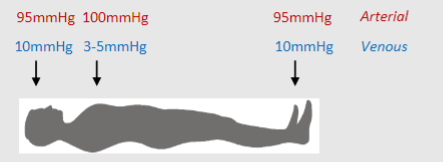
-
Picture demonstrating the Effects of gravity on blood pressures during orthostasis STANDING UP:
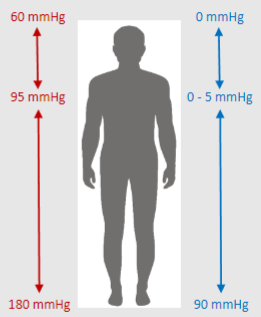
-
What are the effects of gravity on blood pressures during orthostasis (3)
♡ When standing up, gravity causes changes in blood pressure.
♡ Initially, there is a decrease in blood pressure, which can lead to postural hypotension and potential fainting.
♡ However, homeostatic mechanisms like the baroreflex help the cardiovascular system quickly recover and stabilize blood pressure.
-
How does blood flow from the heart to the feet when standing up? (5)
♡ To get arterial blood flow from the heart to the feet when standing up, there needs to be an arterial pressure gradient
♡ The arterial pressure gradient typically ranges from 95 to 180 mmHg
Darcy’s law and Bernoulli’s law explain how blood flow is maintained:
♡ According to Darcy’s law, blood flow depends on the pressure gradient and resistance
♡ Bernoulli’s law states that blood flow involves pressure energy, potential energy, and kinetic energy
♡ With increased potential energy at heart level compared to the feet and increased kinetic energy of ejected blood, blood flows from the heart to the feet
-
What is the equation for pressure in this context?
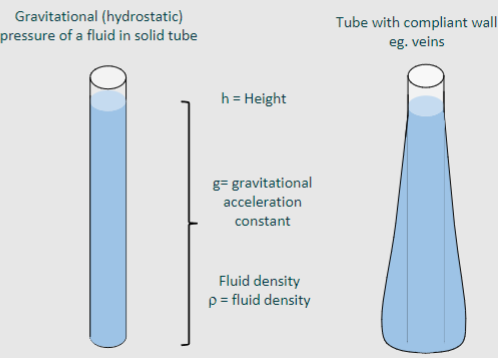
Pressure=p x h x g
-
What causes high venous blood pressures induced by gravity? (3)
♡ High pressure in the venous system at the feet is primarily due to hydrostatic pressure
♡ According to hydrostatic principles, pressure (P) is higher at the bottom of a fluid column
♡ The magnitude of pressure depends on factors such as the height of the fluid column, the density of the fluid, and gravity
-
Picture demonstrating how orthostasis causes hypotension LYING DOWN:
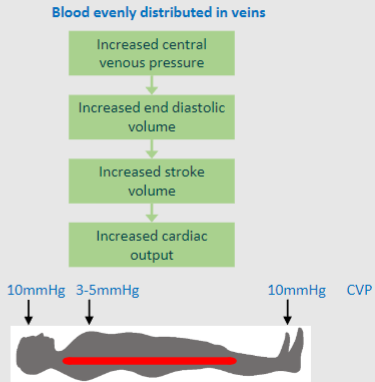
-
Picture demonstrating how orthostasis causes hypotension STANDING UP:

-
What happens in the reflex response to orthostasis? (5)
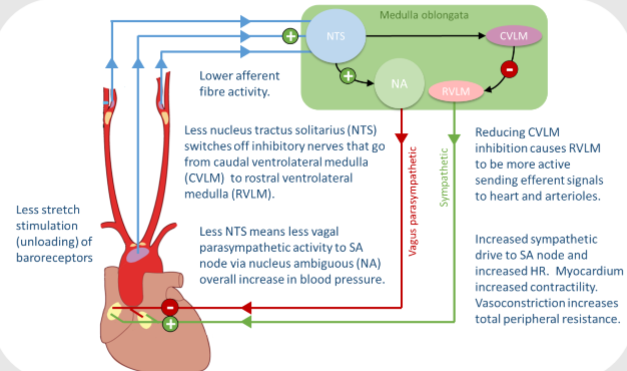
♡ When standing up, there's less stretch stimulation of baroreceptors
♡ This reduces signals to the brainstem, particularly the Nucleus Tractus Solitarius (NTS)
♡ Decreased NTS activity means less inhibition of the caudal ventrolateral medulla (CVLM), which then reduces inhibition of the rostral ventrolateral medulla (RVLM)
♡ With reduced inhibition, the RVLM becomes more active and sends signals to increase sympathetic activity
♡ Increased sympathetic activity leads to higher heart rate, stronger heart contractions, and vasoconstriction, all to maintain blood pressure
-
How does the reflex response to standing up affect the cardiovascular system? (4)
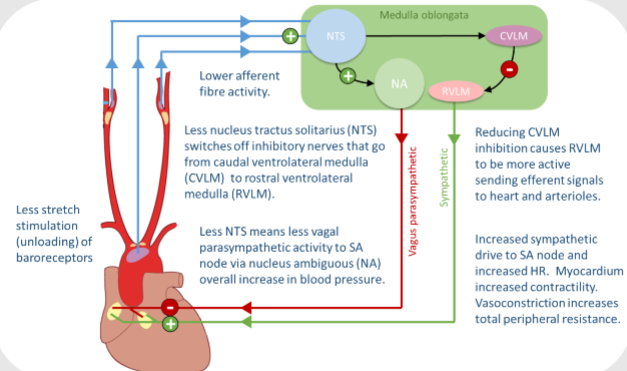
♡ Less stretch stimulation of baroreceptors leads to reduced signals to the brainstem
♡ Decreased activity in the NTS results in less inhibition of the CVLM and subsequently the RVLM
♡ The RVLM becomes more active, increasing sympathetic activity
♡ This leads to higher heart rate, stronger heart contractions, and vasoconstriction to maintain blood pressure
-
What worsens postural hypotension? (5)
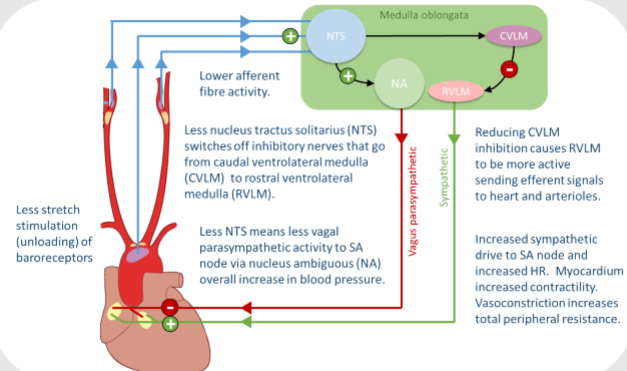
♡ Drugs that reduce vascular tone, such as α-adrenergic blockers or certain calcium channel blockers used for hypertension or angina
♡ Conditions that impair venous return, like varicose veins
♡ Lack of skeletal muscle activity due to paralysis or forced inactivity, such as long-term bed rest or standing for long periods
♡ Decreased circulating blood volume, such as from haemorrhage
♡ Increased core temperature, which causes peripheral vasodilation and less available blood volume, like standing up after a hot bath
-
What are the effects of microgravity on the cardiovascular system? (5)
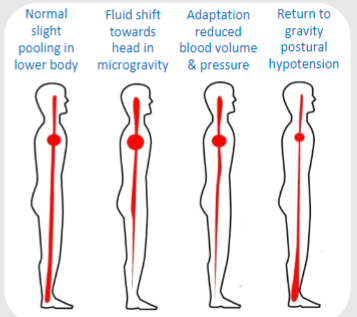
♡ In microgravity, there's a redistribution of blood into the chest region.
♡ Initially, blood doesn't pool in the feet, easily returns to the heart, increases atrial and ventricle volume, preload, and cardiac output.
♡ Cardiac mechanoreceptors sense this and reduce sympathetic activity, leading to decreased ADH and increased ANP.
♡ Long-term effects include reduced blood volume, less stress on the heart, decreased heart muscle mass, and a general drop in blood pressure.
♡ Upon return to gravity, severe postural hypotension occurs due to lower blood volume and a smaller heart, which the baroreceptor reflex can't fully compensate for.
-
What is microgravity? (3)
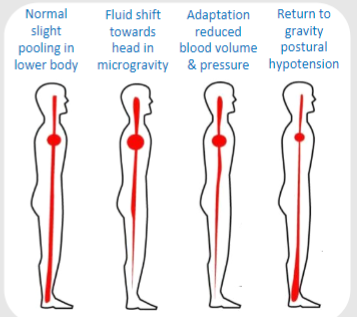
♡ Microgravity refers to the condition experienced in space where the force of gravity is significantly reduced, approaching zero
♡ It occurs when an object is in a state of free fall or orbit around a larger body, such as a planet or a celestial body
♡ In microgravity, objects appear to float because there is very little gravitational force acting on them
-
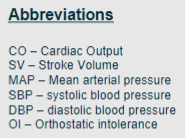
A picture Summary of the CVS effects of microgravity:
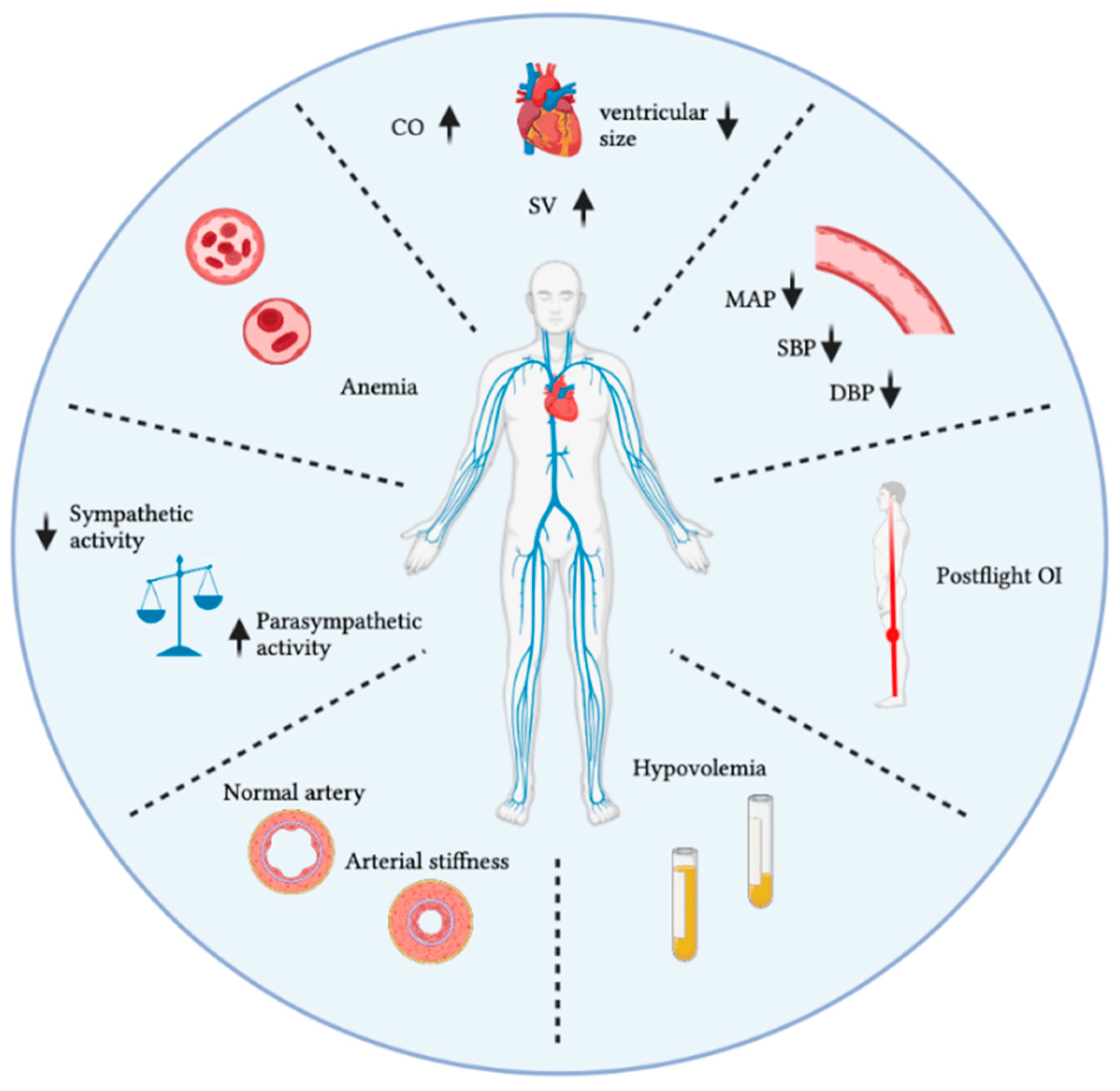
-
What initiates cardiovascular responses during exercise? (2)
♡ Cardiovascular responses to exercise are initiated by central command in the brain.
♡ Even the anticipation of exercise triggers some of these changes
-
How do muscles contribute to cardiovascular responses during exercise? (2)
♡ During exercise, muscles provide feedback through mechanoreceptors and metaboreceptors
♡ This feedback further influences cardiovascular responses.
-
What are the primary effects of exercise on the cardiovascular system? (2)
♡ Exercise increases lung oxygen uptake, transport around the body, and supply to exercising muscles.
♡ It also leads to increased heart rate (HR) and force of contraction
-
How does exercise affect blood pressure control? (2)
♡ Despite significant changes in cardiac output and resistance during exercise, blood pressure is carefully regulated
♡ This regulation protects the heart from excessive afterload, which could otherwise reduce cardiac output
-
What happens to vascular beds during exercise? (2)
-Vascular beds undergo coordinated dilation and constriction during exercise
-This selective targeting ensures that oxygen delivery is prioritized to areas where it is needed most
-
Oxygen uptake by pulmonary circulation can increase10-15 times during strenuous exercise.This very big change brought about by the integration of threesmaller changes:
What are these 3 changes and how much do they increase by in response to exercise?
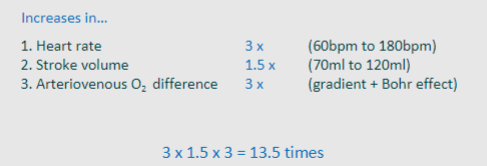
-
Picture demonstrating an increase in O2 uptake from the lungs
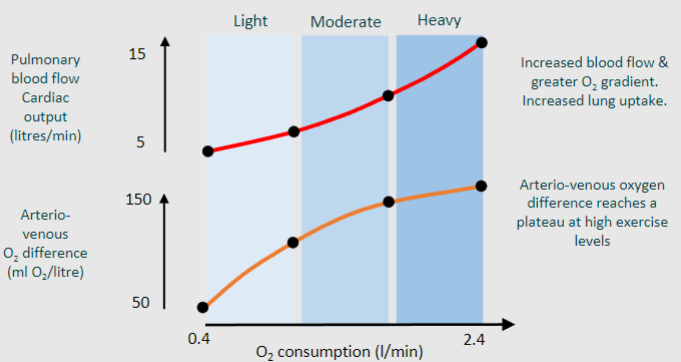
-
Picture demonstrating Increase in cardiac output during exercise
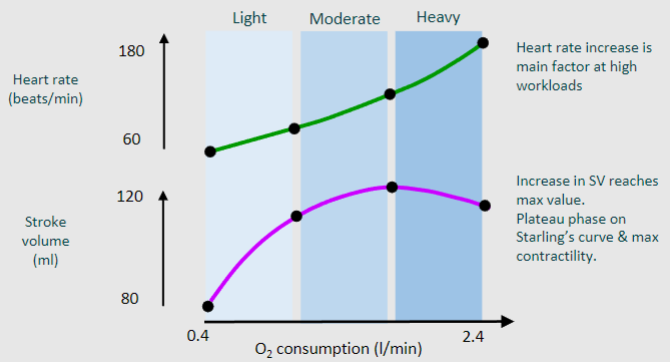
-
How does sympathetic activity affect stroke volume during exercise? (4)
♡ Sympathetic activity increases stroke volume by approximately 1.5 times
This increase is achieved through:
♡ Increased end-diastolic volume due to venoconstriction and increased venous return
♡ Faster ejection facilitated by sympathetic activation of β1 receptors, leading to an inotropic increase in calcium ions
♡ Decreased end-systolic volume due to increased contractility from sympathetic activation of β1 receptors and increased stretching, as per Starling's law
-
What is the overall effect of exercise on cardiac output? (2)
♡ During exercise, cardiac output increases approximately 4.5 times, from around 5 to 22 liters per minute.
♡ This increase results from multiplying heart rate (which triples) by stroke volume (which increases by 1.5 times)
-
How does the body prepare for exercise-induced tachycardia? (3)
♡ The brain's central command prepares the body for exercise
♡ Muscle mechanoreceptors provide fast feedback to the brain regarding the commencement of exercise
This leads to:
♡ Decreased signal transmission down the vagus nerve to the sinoatrial (SA) and atrioventricular (AV) nodes
Increased sympathetic activity to the SA and AV nodes
-
What is the approximate maximum heart rate during exercise? (2)
♡ The maximum heart rate during exercise is approximately calculated as 220 minus age.
♡ For example, for a 30-year-old individual, the approximate maximum heart rate during exercise would be 190 beats per minute
-
How does the body manage the increase in cardiac output during exercise? (3)
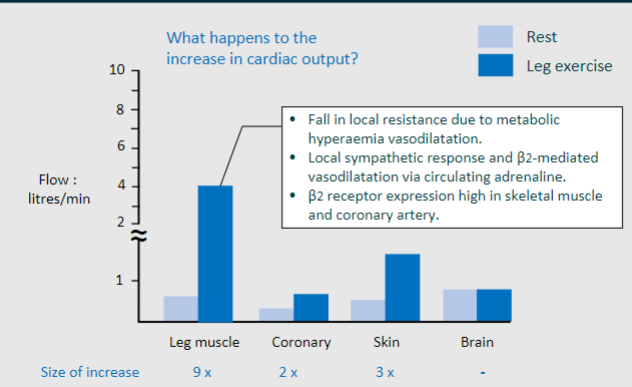
♡ The increase in cardiac output leads to a fall in local resistance due to metabolic hyperaemia vasodilation
♡ There's also a local sympathetic response and β2-mediated vasodilation, facilitated by circulating adrenaline
♡ β2 receptor expression is high in skeletal muscle and coronary arteries, contributing to vasodilation in these areas
-
Effect of increased cardiac output on blood pressure
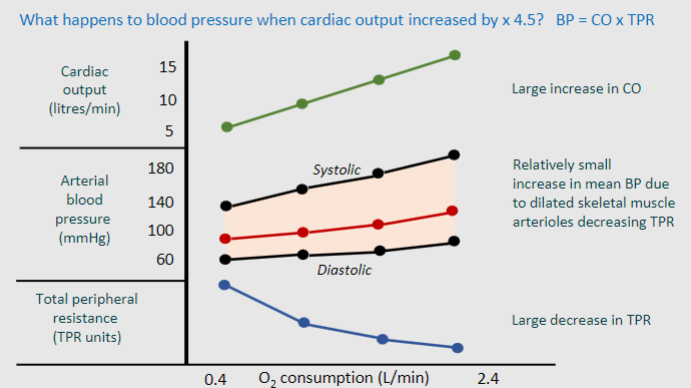
-
How does the body prevent hypotension during exercise-induced decreased total peripheral resistance (TPR)? (4)
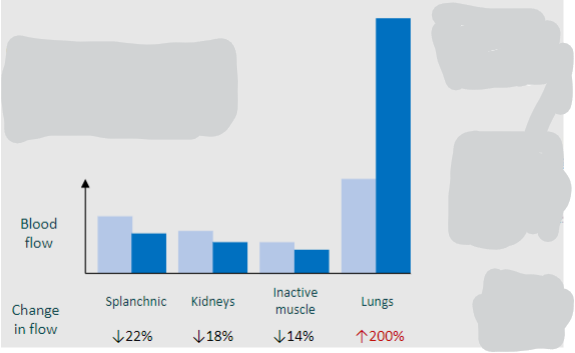
♡ Compensatory vasoconstriction of non-essential circulations occurs to prevent a drop in blood pressure
♡ This vasoconstriction targets inactive or unrequired tissues such as the kidneys, gastrointestinal (GI) tract, and inactive muscle.
♡ The central control mechanism involves the rostral ventrolateral medulla (RVLM), which regulates specific pre-ganglionic sympathetic nerves in the spinal cord. These nerves then send out post-ganglionic nerves to specific tissues.
Additional Information:
♡ Splanchnic circulation refers to blood flow to abdominal organs such as the stomach, liver, spleen, pancreas, and intestines.
-
What are metaboreceptors? (2)
♡ Metaboreceptors are small-diameter sensory fibers found in skeletal muscle
♡ They are chemosensitive, meaning they respond to increased levels of substances like potassium (K+), hydrogen ions (H+), and lactate, which occur during muscle exercise
-
What are the reflex effects of metaboreceptors? (3)
♡ Metaboreceptors trigger reflex responses during exercise:
♡ Tachycardia, through increased sympathetic activity.
Increased blood pressure
♡ Pressor response to exercise, especially prominent during isometric exercise (increased muscle load)
-
How do metaboreceptors contribute to the pressor response to exercise? (3)
♡ Metaboreceptors play a crucial role in the pressor response to exercise, particularly during isometric exercise
♡ Static (isometric) exercise raises blood pressure more than dynamic (isotonic) exercise
♡ Elevated blood pressure helps maintain blood flow to contracted muscles, attempting to force blood into the muscle
-
What is selective metabolic hyperaemia? (2)
♡ Selective metabolic hyperaemia refers to the dilation of resistance vessels supplying contracted muscles due to metabolic activity
♡ It ensures adequate blood flow to active muscles during exercise
-
What distinguishes dynamic exercise from static exercise? (2)
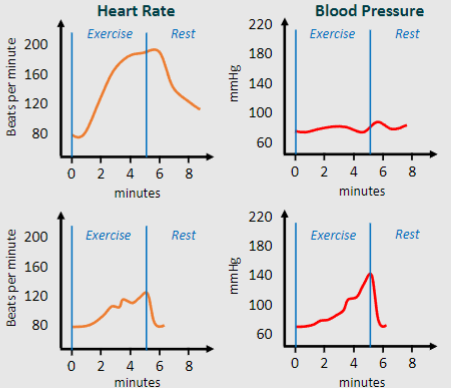
♡ Dynamic exercise involves constant shortening and relaxing of muscle groups with various movements.
♡ Static exercise focuses on working a specific muscle group without constant movement
-
How does dynamic exercise affect blood pressure compared to static exercise? (2)
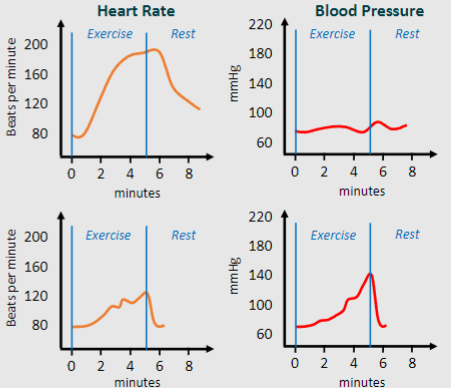
♡ Dynamic exercise typically results in lower blood pressure compared to static exercise.
♡ This is because dynamic exercise involves multiple muscle groups and movements, leading to lower sympathetic tone and less impact on blood pressure
-
Why does static exercise tend to raise blood pressure more than dynamic exercise? (2)
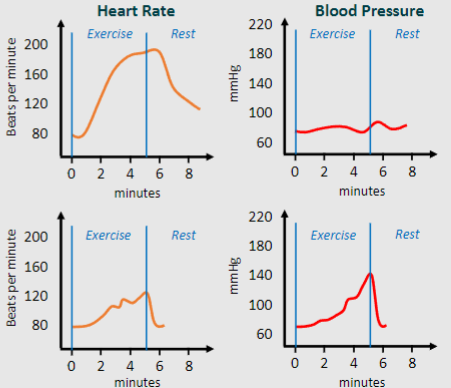
♡ Static exercise raises blood pressure more due to local metabolic hyperaemia
♡ During static exercise, the specific muscle group being worked experiences increased metabolic activity, leading to localized vasodilation and higher blood pressure
-
Picture summary of cardiovascular responses in exercise
